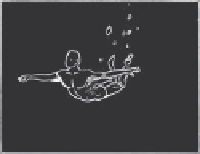Graphics Reference
In-Depth Information
Festivals
Thirty or so years ago the idea of a i lm festival devoted solely to animation, getting your i lm
shown and discussed and meeting fellow i lm-makers, was extraordinary, but there are now
festivals around the world, all operating dif erently. Originally, most festivals happened every
two years as there was neither the new material nor the audience to be annual events, but
that has by and large changed. Each festival has its own theme and criteria about the i lms
they want to show. Some show a whole range, others specialise in a technique, while some
prefer genres such as science i ction, or specii c audiences of, perhaps children, or a particular
message. If a i lm is rejected by a festival, it doesn't mean necessarily that they don't like it. It
may simply not i t their scheme of things. But there is nothing to rival the i rst screening of your
latest i lm at a festival. Terrifying and exciting in equal measures. Festival audiences usually
adore animation with real fervour. There's always a buzz, an openness and a willingness to swap
stories.
The perks of this job: the lake at Annecy
Most festivals of er awards, some are which are a fancy piece of sculpture, others a certii cate,
while some of er substantial cash awards. Most awards are decided during the week by
hardworking juries who spend their week locked away in a room watching unimaginable
hours of i lms, while usually battling half a dozen dif erent languages and customs, and trying
to avoid the accusatory and l irtatious looks of hopeful i lm-makers. Discussions are rarely less
than heated and passionate, and all manner of reasons are of ered for wanting particular i lms
to win. I've been on many juries and usually the discussions are very rational, although I can't
pretend that a bottle of vodka, or more, has not been waved in my direction as gentle, bribe is
too strong, persuasion. As a non-drinker and in spite of tears from a jury member pleading for
her favoured i lm to win, that was a lost cause on me.
It's hard to say what makes an award-winning i lm. A certain standard and clear
innovation impress straight away, but it's probably more about a i lm achieving
what it set out to do, and doing it well. It's not always about saying something
deeply moving or signii cant, as small, simple i lms about the most trivial of
incidents, but which are beautifully told, can still win. It's probably about exploiting
the language of animation, to tell some story that other mediums cannot. The big



Search WWH ::

Custom Search